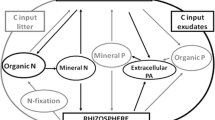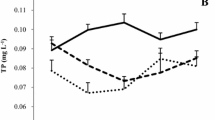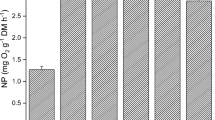Abstract
This study compares soluble phenolics and lignin content in two wetland macrophytes with contrasting life strategies grown under a varying nutrient supply in the field and in a greenhouse experiment. The differences are explained in terms of the protein competition model (PCM) hypothesis relating changes in secondary metabolites to changing nutrient limitation. The two study species, Eleocharis cellulosa (EC) and Typha domingensis (TD), are both widespread in tropical and subtropical freshwater and brackish marshes of the New World, and are often found in P-limited rather than N-limited conditions. TD is a fast-growing competitor with large nutrient requirements. EC is a stress tolerator, quite well adapted to growth in nutrient-limiting environments. In both species, the concentration of phenolics was negatively correlated with increasing growth (due to increasing nutrient levels). This is in agreement with the PCM hypothesis, which predicts an increase in phenolic synthesis when protein synthesis (and consequently growth) is low due to limited resource availability. An interesting difference was found in the correlation between tissue nutrients and phenolics. TD from both the field and the greenhouse showed a negative correlation between tissue P and phenolics, while EC displayed a significant negative correlation between tissue N and phenolics. EC is adapted to low P, and increased tissue P content represents luxury consumption (uptake of P for storage) which is not reflected in increased growth and thus is not correlated with phenolics. These are the first steps in elucidating the relationship among nutrient availability, growth and phenolic content in two important primary producers of tropical and subtropical marshes.



Similar content being viewed by others
References
Aerts R, Berendse F (1988) The effect of increased nutrient availability on vegetation dynamics in wet heathlands. Vegetatio 76:63–69
Aerts R, de Caluwe H (1997) Initial litter respiration as indicator for long-term leaf litter decomposition of Carex species. Oikos 80:353–361
Aerts R, Chapin III FS (2000) The mineral nutrition of wild plants revisited: A re-eavaluation of processes and patterns. Advances Ecol Res 30:1–67
Bärlocher F, Biddiscombe NR (1996) Geratology and decomposition of Typha latifolia and Lythrum salicaria in a freshwater marsh. Arch Hydrobiol 136:309–325
Bezemer TM, Jones TH, Newington JE (2000) Effect of carbon dioxide and nitrogen fertilization on phenolic content in Poa annua L. Biochem Syst Ecol 28:839–846
Bolser RC, Hay ME, Lindquist N, Fenical W, Wilson D (1998) Chemical defenses of freshwater macrophytes against crayfish herbivory. J Chem Ecol 24:1639–1658
Bryant JP, Chapin III FS, Klein DR (1983) Carbon/nutrient balance of boreal plants in relation to vertebrate herbivory. Oikos 40:357–368
Close DC, McArthur C (2002). Rethinking the role of many pant phenolics – protection from photodamage not herbivores? Oikos 99:166–172
Craft CB, Vymazal J, Richardson CJ (1995) Response of Everglades plant communities to nitrogen and phosphorus additions. Wetlands 15:258–271
Downing JA, McClain M, Twilley R, Melack JM, Elser JJ, Rabalais NN et al. (1999) The impact of accelerating land-use change on the N-cycle of tropical aquatic ecosystems: Current conditions and projected changes. Biogeochemistry 46:109–148
Feller IC, Wigham DF, O’Neill JP, McKee KL (1999) Effects of nutrient enrichment on within-stand cycling in a mangrove forest. Ecology 80:2193–2205
Godshalk GL, Wetzel RG (1978) Decomposition of aquatic angiosperms. II. Particulate components. Aquatic Bot 5:301–327
Hamilton JG, Zangerl AR, DeLucia EH, Berenbaum MR (2001) The carbon-nutrient balance hypothesis: its rise and fall. Ecol Letters 4:86–95
Harborne JB (1997) Plant secondary metabolism. In Crawley MJ (ed) Plant Ecology. Blackwell Science, Oxford pp 132–155
Hättenschwiler S, Vitousek PM (2000) The role of polyphenols in terrestrial ecosystem nutrient cycling. Trends Ecol Evol 15:238–243
Herms DA, Mattson WJ (1992) The dilemma of plants: to grow or to defend. Quatern Rev Biol 67:283–335
Hol WHG, Vrieling K, van Veen JA (2003) Nutrients decrease pyrrolizidine alkaloid concentrations in Senecio jacobea. New Phytol 158:175–181
Iiyama K, Wallis AFA (1989) Determination of lignin in herbaceous plants by an improved acetylbromide procedure. J Sci Food Agric 51:45–161
Jones CG, Hartley SE (1999) Protein competition model of phenolic allocation. Oikos 86:27–44
Kagata H, Ohgushi T (2011) Ecosystem consequences of selective feeding of an insect herbivore: palatability–decomposability relationship revisited. Ecol Entomol 36:768–775
Karban R, Myers JH (1989) Induced plant responses to herbivory. Annual Rev Ecol Syst 20:331–348
Koricheva J, Larsson S, Haukioja E, Keinanen M (1998) Regulation of woody plant secondary metabolism by resource availability: hypothesis testing by means of meta-analysis. Oikos 83:212–226
Koricheva J (1999) Interpreting phenotypic variation in plant allelochemistry: problems with the use of concentrations. Oecologia 119:467–473
Lacki MJ, Penneston WT, Adams KB, Vot FD, Houppert JC (1990) Summer foraging patterns and diet selection of muskrats inhabiting a fen wetland. Canad J Zool 68:1163–1167
Lege M (2000). Biology of Pomacea flagellata in marshes of northern Belize. MS thesis, Department of Environmental Science and Policy, University of California, Davis
Maie N, Jaffe R, Miyoshi T, Childers DL (2006) Quantitative and qualitative aspects of dissolved organic carbon leached from senescent plants in an oligotrophic wetland. Biogeochemistry 78:285–314
Miao SL, Sklar FH (1998). Biomass and nutrient allocation of sawgrass and cattail along a nutrient gradient in the Florida Everglades. Wetlands Ecol Managem 5:245–263
Mole S, Joern A (1993) Foliar phenolics of Nebraska sandhills prairie graminoids: between-years, seasonal, and interspecific variation. J Chem Ecol 19:1861–1874
Novaes E, Kirst M, Chiang V, Winter-Sederoff H, Sederof R (2010) Lignin and Biomass: A Negative Correlation for Wood Formation and Lignin Content in Trees. Pl Physiol 154:555–561
Parr AJ, Waldron KW, Ng A, Parker ML (1996) The wall-bound phenolics of Chinese water chestnut (Eleocharis dulcis). J Sci Food Agric 71:501–507
Pavia H, Toth G, Aberg P (1999). Trade-offs between phlorotannin production and annual growth in natural populations of the brown seaweed Ascophyllum nodosum. J Ecol 87:761–771
Peñuelas J, Estiarte M (1998) Can elevated CO2 affect secondary metabolism and ecosystem function? Trends Ecol Evol 13:20–24
Quayyum HA, Mallik AU, Leach DM, Gottardo C (2000) Growth inhibitory effects of nutgrass (Cyperus rotundus) on rice (Oryza sativa) seedlings. J Chem Ecol 26:2221–2231
Reichardt PB, Chapin III FS, Bryant JP, Mattes BR, Clausen TP (1991) Carbon/nutrient balance as a predictor of plant defense in Alaskan balsam polar: Potential importance of metabolite turnover. Oecologia 88:401–406
Rejmánková E (2001) Effect of experimental phosphorus enrichment on oligotrophic tropical marshes in Belize, Central America. Pl & Soil 236:33–53
Rejmánková E, Pope KO, Pohl MD, Rey-Benayas JM (1995) Freshwater wetland plant communities of northern Belize: Implications for paleoecological studies of Maya wetland agriculture. Biotropica 27:28–36
Rejmánková E, Pope KO, Post RA, Maltby E (1996). Herbaceous wetlands of the Yucatan Peninsula: Communities at extreme ends of environmental gradients. Int Rev Gesamten Hydrobiol Hydrogr 81:225–254
Rejmánková E, Komárková J (2000) A function of cyanobacterial mats in phosphorus-limited tropical wetlands. Hydrobiologia 431:135–153
Rejmánková E, Snyder JM (2008) Emergent macrophytes in phosphorus limited marshes: do phosphorus usage strategies change after nutrient addition? Pl & Soil 313:141–153
Rejmánková E, Macek P, Epps K (2008) Wetland ecosystem changes after three years of phosphorus addition. Wetlands 28:914–927
Richardson CJ, Ferreli GM, Vaithiyanathan P (1999) Nutrient effects on stand structure, resorption efficiency, and secondary compounds in Everglades sawgrass. Ecology 80:2182–2192
Sah RN, Miller RO (1992) Spontaneous reaction for acid dissolution of biological materials in closed vessels. Analytical Chem 64:230–233
Schindler DW (2012) The dilemma of controlling cultural eutrophication of lakes. Proc Roy Soc London Ser B, Biol 279:4322–4333
Smolders AJP, Vergeer LHT, van der Velde G., Roelofs JGM (2000) Phenolic contents of submerged, emergent and floating leaves of aquatic and semi-aquatic macrophyte species: why do they differ? Oikos 91:307–310
Snyder JM, Rejmánková E (2015) Macrophyte root and rhizome decay: the impact of nutrient enrichment and the use of live versus dead tissue in decomposition studies. Biogeochemistry 124:45–59
Stamp N (2003) Out of the quagmire of plant defense hypotheses. Quatern Rev Biol 78:23–55
Taylor BR, Parkinson D, Parsons WFJ (1989) Nitrogen and lignin content as predictors of litter decay rates: A microcosm test. Ecology 70:97–104
Vitousek PM (1998) Foliar and litter nutirents, nutirent rresorption, and decomposition in Hawaiian Metrosideros polymorpha. Ecosystems 1:401–407
Waterman PG, Mole S (1994) Analysis of Plant metabolites – Methods in Ecology Series. Blackwell Scientific Publications, Oxford
Wong PK, Liang Y, Liu NY, Qiu JW (2010) Palatability of macrophytes to the invasive freshwater snail Pomacea canaliculata: differential effects of multiple plant traits. Freshwater Biol 55:2023–2031
Wright DM, Jordan GJ, Lee GW, Duncan RP, Forsyth DM, Coomes DA (2010). Do leaves of plants on phosphorus-impoverished soils contain high concentrations of phenolic defence compounds? Funct Ecol 24:52–61
Acknowledgements
I thank Marcel Rejmánek, Brenda Grewell and two anonymous reviewers for comments on the manuscript. Jian Huang’s help with chemical analyses is appreciated. This research was supported by the Faculty Research Fund and partly by the by NSF grant No. 0089211.
Author information
Authors and Affiliations
Corresponding author
Additional information
To the memory of Dr Dagmar Dykyjová – my great role model and mentor
Rights and permissions
About this article
Cite this article
Rejmánková, E. Phenolic content and growth of wetland macrophytes: Is the allocation to secondary compounds driven by nutrient availability?. Folia Geobot 51, 239–250 (2016). https://doi.org/10.1007/s12224-015-9227-7
Received:
Accepted:
Published:
Issue Date:
DOI: https://doi.org/10.1007/s12224-015-9227-7




